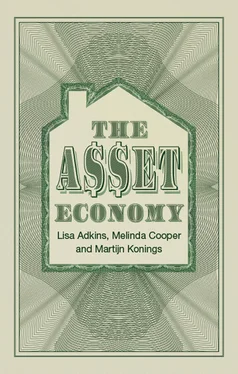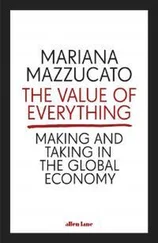The key element shaping inequality is no longer the employment relationship, but rather whether one is able to buy assets that appreciate at a faster rate than both inflation and wages. Employment remains an important factor as it shapes the ability to purchase assets (e.g. the ability to service a mortgage), but it is increasingly only one among other factors. Of course, income from work remains vitally important for many people as a way to access subsistence goods, but the important point is that by itself it is less and less able to serve as the basis of what most people would consider a middle-class lifestyle. Asset appreciation has been engendered by a specific institutional nexus that has fundamentally redrawn the social structure – such that asset ownership is now becoming more important than employment as a determinant of class position.
The millennial generation is the first to experience this reality in its full force. So, the generational aspect is important not because it produces a uniform experience of social life or a clean divide between different generations (as a naïve approach to generational analysis would imply), but precisely because it is where the economic fault-lines that four decades of neoliberal fiscal and financial policies have produced are becoming visible. After all, some millennials have access to parental wealth (often itself the result of property inflation) that allows them to buy into dynamics of asset inflation. What we are seeing in the present era is the growing importance of intergenerational transfer and inheritance for the determination of life chances.
Crucially, however, this is not best understood as a return to an earlier era, when property was passed on (generally among men) from one generation to another in a more or less stable and mostly uneventful way. Inheritance is no longer a simple transmission of property titles, but increasingly a strategically timed transfer of funds that need to be leveraged and put to work in the speculative logic of the asset economy. This new logic of inequality has mixed ‘hypercapitalist’ logics of financialization with ‘feudal’ logics of inheritance to reshape the social class structure as a whole. The generational dimension interacts with the speculative logic of the contemporary financial system to shape asset-based lifetimes.
In the following chapters, we will show how the changing role of assets has been responsible for the creation of a new logic of inequality in Anglo-capitalist societies. In the next chapter, ‘Asset Logics’, we explain the importance of thinking of the contemporary economic system as dominated by the logic of assets. We differentiate our approach from competing perspectives that tend to overemphasize the orthodox image of the market and in particular the idea that liquidity is an inherent aspect of financialization. Such perspectives neglect the fact that participation in the financialized economy often involves (and regularly necessitates) making highly illiquid investments. The typical economic actor needs to take on debt in order to finance an asset purchase and then needs to pay down the debt over an extended period of time, relying on returns and capital gains from the asset as well as separate earnings from work. As the latter stagnate, the role of speculative asset gains becomes more and more important (both to the quality of individual and household balance sheets and to overall macroeconomic performance and policy).
The chapter then turns to Piketty’s observation that the growth of asset values has outstripped returns on labour over the past four decades. This is a key point of reference for our book, but Piketty’s account has two key weaknesses. First, he understands the tendency for capital income to exceed labour income as the reassertion of a basic law of capital rather than as an outcome of a series of transformations in fiscal and monetary policy that have shifted inflationary pressures from consumer prices and wages to asset prices. The chapter indicates some of the key aspects of this policy configuration, which are examined in more detail in the following chapter, ‘The Making of the Asset Economy’. Second, Piketty’s focus and that of others following his analysis has been skewed towards the very top layers of the population (the 1%), and they have generally not pursued the implications for a more general understanding of class and stratification. This is where some distance is needed from the idea that the current era represents a return to classic liberalism or a ‘new gilded age’. Contemporary inequality in Western countries is built on a base of middle-class asset ownership that evolved during the post-New Deal and post-war era. This is especially evident in the area of housing: the sustained inflation of property values over several decades has fundamentally shifted the social class structure, from a logic that was structured around employment towards one that is organized around participation in asset ownership and appreciation.
The next chapter, ‘The Making of the Asset Economy’, discusses the origins and development of asset inflation in more detail, aiming to understand how we arrived in a situation where continuous asset price inflation has replaced wage inflation as a key economic driver. To this end, it returns to the 1970s, a decade that saw historic declines in asset prices as consumer price inflation cut into the returns on assets, combined with the growth of wages and welfare state expenditure as trade unions sought to keep up with or even outpace the rise in consumer prices. Over the next decades, this combination of high wage inflation and asset price depreciation was reversed. The chapter examines the role of monetary policy, taxation policy (notably capital gains taxation) and public spending constraints as the primary levers by which this reversal was effected and the asset inflation/wage stagnation norm was forged.
This chapter also elucidates the role of Third Way neoliberals such as Bill Clinton in the US, Tony Blair in the UK and Paul Keating in Australia in softening, but also consolidating, this new policy regime by offering consumer credit as a pathway towards democratized capital gains – a kind of asset-owning democracy. Anticipated by Margaret Thatcher and Ronald Reagan, Third Way neoliberals offered up the hope that we could all participate in asset price appreciation, via a democratization of stock ownership, home ownership, or simply ownership of our own skills (our ‘human capital’). The Third Way take on human capital theory imagined that, by adopting an entrepreneurial investor stance towards life, people could compensate for stagnant income from labour through income from their human capital on a permanent basis and that this could altogether neutralize the antagonism between employees and employers. Fiscal and monetary policy became heavily driven by the notion that life course events such as education, housing and employment are above all to be seen as investment opportunities.
The final chapter in this book, ‘New Class Realities’, shows how forty years of asset inflation and wage stagnation have exposed the limits of this Third Way vision. It is in housing, already widely distributed across the population (at least in Anglo-American countries) at the start of the neoliberal era, where the promise of inclusion in capital gains has mostly played out. The combination of rising house prices, low interest rates and the democratization of mortgage credit has meant that substantial parts of populations in Anglo-capitalist countries have been able to participate in asset-based capital gains. But the reality of this has been both less utopian and less universal than that projected by the architects of the democratized asset ownership project. Home ownership has just as often entailed greater reliance on stagnant wages as it has meant economic independence. Only the top layer of the population, holding diversified asset portfolios that benefit from various forms of preferential tax treatment, may be said to approximate an ideal of asset ownership. Moreover, the very logic of asset appreciation means that growing segments are unable to buy into it.
Читать дальше












